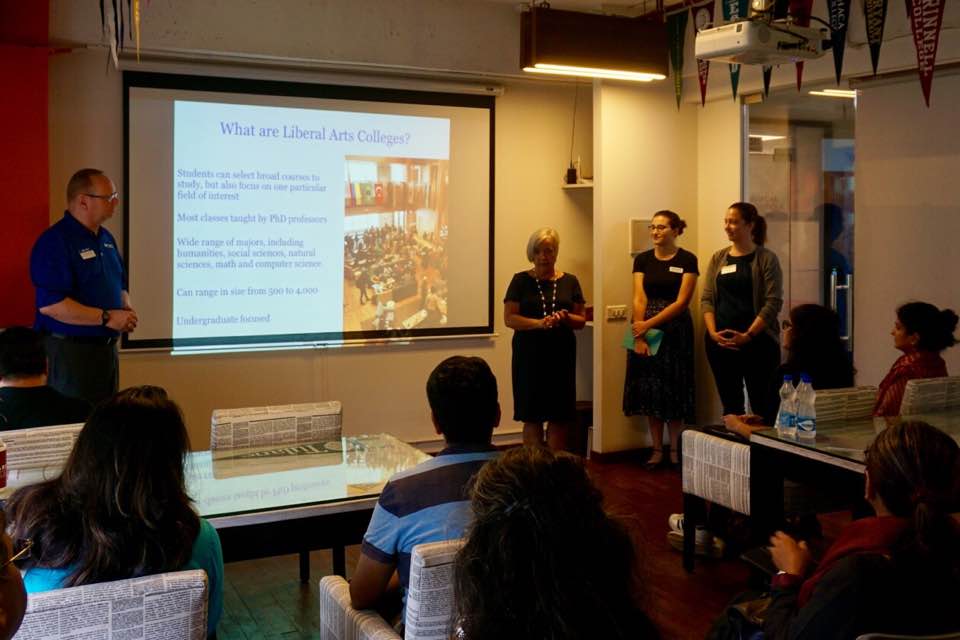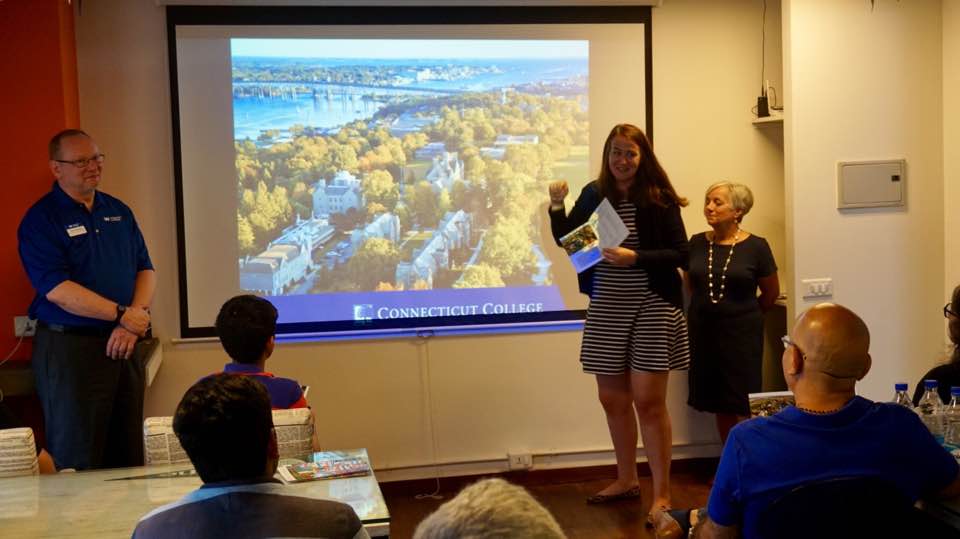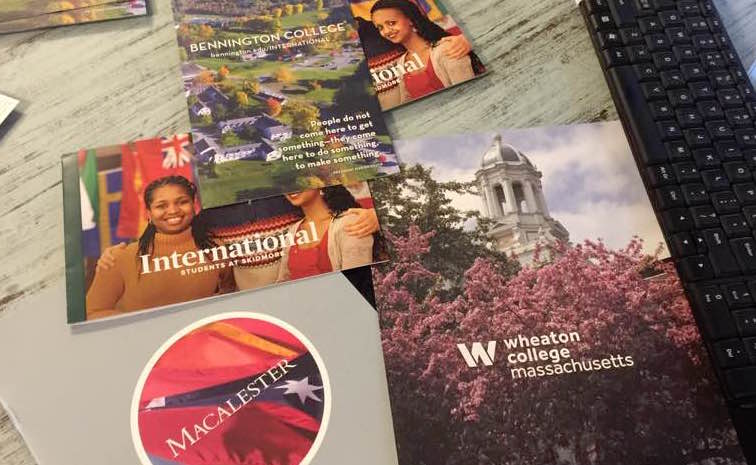A Few Liberal Arts Colleges Visited our Offices this Weekend!
College reps from Skidmore, Macalester, Bennington, Connecticut, and Wheaton College representatives met our students in Gurgaon this beautiful weekend! They shared information about their institutions, admissions process, and an interactive questionnaire thereafter.
Here is a profile of the colleges that visited us and key takeaways from the event:
Skidmore College:
Founded in 1903 as the Young Women’s Industrial Club of Saratoga, co-ed Skidmore College serves up solid academics with a decidedly nontraditional flair. Freshmen are immediately integrated into school culture at Skidmore College. Through the First Year Experience Program, freshmen are paired up with peer mentors and placed in introductory Scribner Seminars. Freshmen must live on campus in dorms near other students in their seminar.
The most popular majors at Skidmore are business, psychology, English, art, and government. Not coincidentally, students say these are some of the college’s best programs as well. Biology, environmental studies, and geoscience majors may con- duct fieldwork in the college’s 300-acre North Woods, a natural laboratory.
Through the Hudson-Mohawk Association of Colleges and Universities, students may take courses at most other colleges nearby. There are also cooperative programs in engineering with Dartmouth and Clarkson, a Washington semester with American University, a semester at the Marine Biological Laboratory in Woods Hole, Massachusetts, a master of arts in teaching with Union University, and M.B.A. programs with Clarkson and Union. The college has also established the Skidmore Analytical Interdisciplinary Laboratory (SAIL), an integrated research instrumentation cluster that enables faculty and students in biology, chemistry, environmental studies, and anthropology to engage in research that links molecular composition to the structure and function of biological, chemical, environmental, and anthropological systems.
Students believe that classes are engaging but don't feel as though they are competing with their peers. Students are generally happy and have a lot do outside the classroom even though there is no greek life.
Macalester College:
Macalester is known as an international liberal arts college. It has one of the strongest International studies program in the country and prides itself on being the only liberal arts college in a city setting in all of the Midwest. Mac’s general requirements include two courses in social sciences, a course in quantitative reasoning, a course in writing, and two in natural sciences and math, plus one to two courses in fine arts and in humanities. Two courses must address cultural diversity, in the United States and internationally. Every student also completes a capstone experience during his or her senior year, such as an independent research project, performance, artistic work, or original work. Mac’s academic strengths include economics, chemistry, and biology; the school’s impressive science facilities include an observatory, an animal operant chamber, and labs for electronic instrumentation and laser spectroscopy. New majors include media and cultural studies and international development.
Eighteen percent of Macalester students hail from Minnesota, and the rest come from every state, the District of Columbia, and dozens of other countries. Despite Mac’s small size, the student body is 4 percent African American, 6 percent Hispanic, and 6 percent Asian American—and a whopping 11 percent of the student body are international. Political debate is lively. Merit scholarships worth an average of $7,347 each are available however there are no athletic scholarships. Housing is average with over 60% of students living in campus housing.
While there is no greek life, students loved their social life on and off college. Macalester churns out great students with strong reasoning skills and an ability to sell themselves well. If you can bear the cold, this is can be a great investment.
Bennington College:
Bennington College is a school where architects are teachers, biologists sculpt, and a sociologist might work on Wall Street or in graphic design. It’s no wonder they strive to abandon the theory of regimented knowledge. Bennington’s focus is on learning by doing. The emphasis on self-direction, field work, and personal relationships with professors sets it apart even from other liberal arts colleges of similar (small) size. Bennington sits on 470 acres at the foot of Vermont’s Green Mountains. Dickinson Science Building offers high-tech equipment for aspiring chemists, biolo- gists, environmental scientists, and geneticists. The building is also home to a media lab dedicated to the study of languages, including Chinese, French, Italian, Japanese, and Spanish. A 14,000-square-foot student center offers students a snack bar, grill, convenience store, and multipurpose spaces. The Center for the Advancement of Public Action opened in 2011 and includes space for students and faculty centering their work in public action to collaborate with each other and to engage with people whose lives and work are dedicated to solving pressing world problems.
As Bennington lacks traditional departments, requirements, and even faculty tenure, it’s probably not surprising that the school also lacks dorms. Ninety-four percent of students live in one of the college’s co-ed houses; 12 are white New England clapboard, and three are more modern.
Without academic departments, the faculty works to provide students with a well-rounded academic foundation. The most popular area of study is visual and performing arts, followed by English, social sciences, foreign languages, and liberal arts. Dance is a long-standing strength and social and biological sciences remain popular. Social life centers on rehearsals, performances, films, and lectures. Although the vibe on Bennington’s campus is liberal, sophisticated, and cosmopolitan, the neighboring town of the same name—four miles away—is far more conservative, typical of rural New England. Given Bennington’s rugged location, hiking, rock climbing, caving, camping, and canoeing keep students moving. Ski slopes beckon in the colder months. Twice each year, the college turns part of its huge Visual and Performing Arts complex into an indoor roller rink for a Rollerama party. For 12 hours one day each May, the cam- pus celebrates spring with Sunfest, which includes bands, games, and other events.
Bennington is a place where there is nothing like the road less travelled. Everyone is doing something special and making the most of their lives. If you are looking for a curriculum as free as night and day, think of this college; the Reed of the North!
Connecticut College:
Placed majestically atop a hill, the Conn College campus sits within a 750-acre arboretum with a pond, wetlands, wooded areas, and hiking trails. It offers beautiful views of the Thames River. The granite campus buildings are a mixture of modern and collegiate Gothic in style, with some neo-Gothic and neoclassical architecture thrown in for good measure. The college is slated to complete a $20 million renovation and expansion of New London Hall this year, which will dramatically expand space and resources for life and computer sciences.
Conn’s dance and drama departments are superb, and it’s not uncommon for dancers to take time off to study with professional companies. Aspiring actors, directors, and stagehands may work with the Eugene O’Neill Theater Institute, named for New London’s best-known literary son. Chemistry majors may use high-tech gas chromatograms and mass spectrometers from their very first day, and students say Conn also offers excellent programs in biology and physics. The Ammerman Center for Arts and Technology allows students to examine the connections between artistic pursuits and the worlds of math and computer science. The most popular majors are economics, biology, environmental studies, English, and international relations. The teacher certification program also wins raves. Over half of students study abroad, and virtually any major can be “internationalized” through language study or paid overseas internships. Conn also participates in the Twelve College Exchange Program, bringing the total number of foreign study programs to more than 40.
Only 13 percent of Conn College students come from Connecticut, and 49 percent graduated from public high schools. African Americans comprise 4 percent and Asian Americans make up 3 per- cent of the student body, respectively; Hispanic students add 6 percent. Because Conn lacks a Greek system, most activities—including co-ed intramural sports—revolve around the dorms, which sponsor weekly keg and theme parties. Also keeping students busy are movie nights, comedy shows, student productions, and dances—sometimes with out-of-town bands and DJs. Conn College fosters strong student/faculty bonds and takes pride in its ability to challenge—and trust—students, both in and out of the classroom. Its a place for people who strive to different because to be honest, everyone is extremely unique here.



